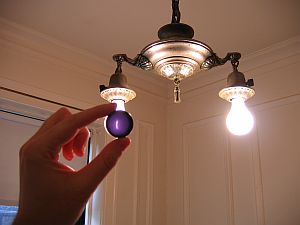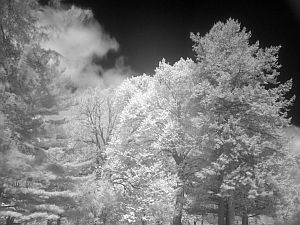All of the images were normalized with "Auto Levels" in Photoshop and desaturated to greyscale. The raw images are very purple and underexposed.

The filter material
was color negative film, fully exposed and processed, stacked
up in three. This sandwich is opaque to the eye except for
bright filaments. There is leakage around the sides of the filter when I place it on the camera lens, and since it's just negative film, there are significant reflections between the three pieces, creating a hotspot in the center of the frame.

In the camera, all three channels respond,
although the green is weaker than red and blue. The response
from all three channels must be the residual near-IR leakage
through the color filters, and scenes appear to be the same if
you compare each color channel. With a two layer sandwich you
begin to see more red light come through, and this creates a
neat contrast between near-infrared-red and near infrared:
http://www.lib.uchicago.edu/~dean/blog/ir2-auto.jpg. There is
a normal visual comparison at
http://www.lib.uchicago.edu/~dean/blog/ir-normal.jpg.
The exposures are roughly 1000x longer with the filter in bright sunlight.
In the next post, I'll discuss some interesting details about near-infrared light: plants, automotive windows, and currency.
And split screen comparisons with normal visual images.
Visual Infrared Comparisons
Plants in the near infrared
Linne Statue in the near infrared
IR bushes
IR hosta (or plantain lily)
1 comment:
Post a Comment